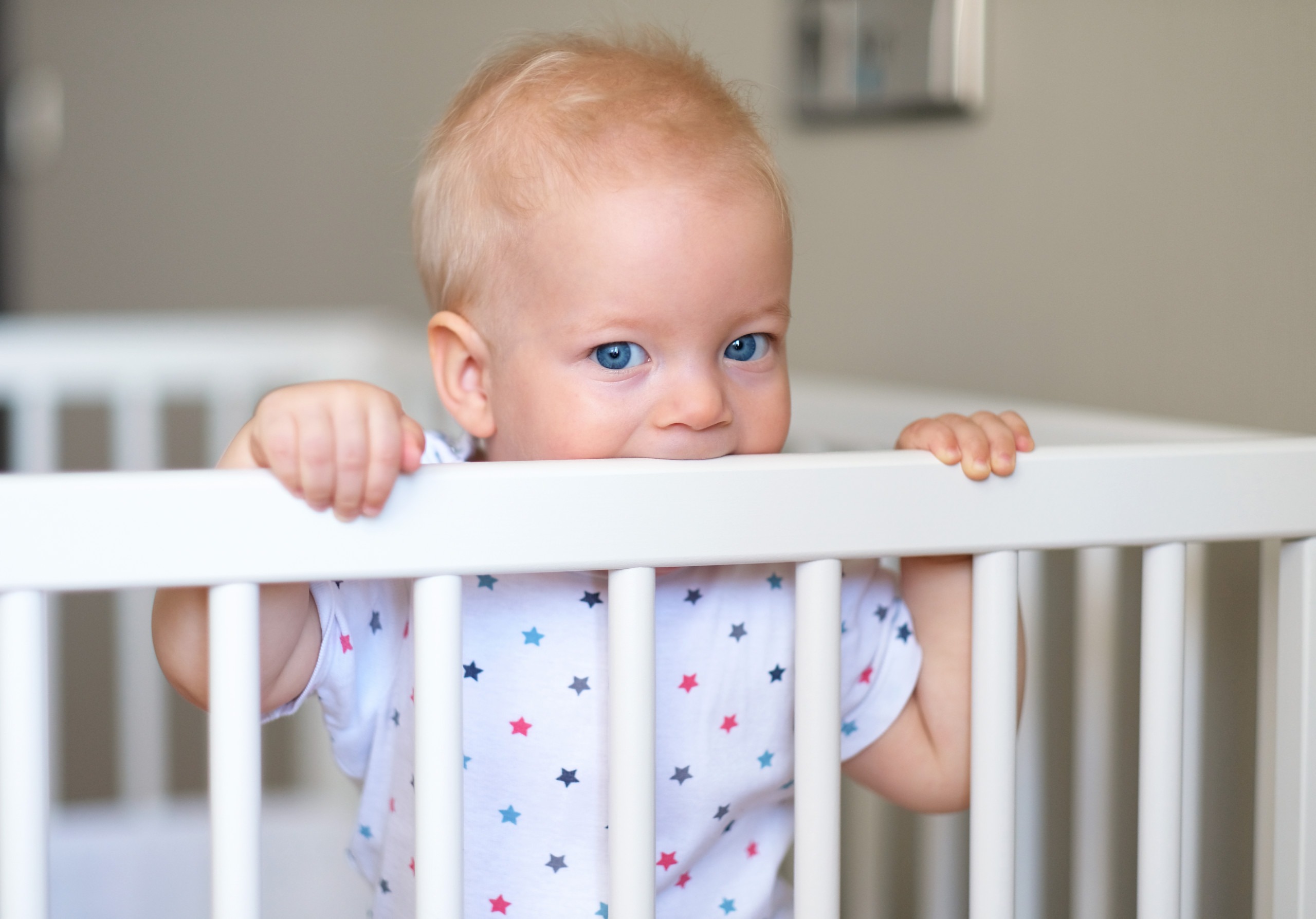Most new parents have never heard the phrase ‘wake window’ before their baby is born. Now, it’s all they can think about!
What is a ‘wake window’? Are your baby’s wake windows too long or too short? How do wake times affect your baby’s sleep?
Don’t worry! This article explains it all. You’ll learn what wake windows are, how they contribute to healthy sleep for your baby and the exact wake windows for sleep to use at each age. Plus, you’ll get a wake windows chart by age you can reference. Let’s get started!
What you’ll learn:
– What are Wake Windows for Babies?
– Why Wake Windows are Important
What are Wake Windows for Babies?
Wake windows for your little one are exactly what they sound like. It is the amount of time your baby is awake between periods of sleep.
For example, from the time they wake up in the morning until they’re asleep for their first nap. Or the length of time between 2 naps.
Wake windows are the ideal amount of time babies and toddlers can stay awake between sleeps ensuring they don’t get under-tired or overtired.
I count a wake window from the moment your baby wakes up until the next time they fall asleep. This means that even if you don’t get your baby up right away when they wake up, you still calculate the wake window from the time they actually woke up.
I recommend paying attention to your baby’s wake windows by age from birth as this helps your newborn sleep easily and prevents over-tiredness.
Why Wake Windows are Important
Now that you know what a wake window is, let’s look at why they matter. Babies and young toddlers need to sleep during the day.
Developmentally speaking, they can’t handle long stretches of being awake. In fact, keeping your baby awake for a long time because you’re hoping it will help them sleep better at night tends to backfire. Baby sleep is counterintuitive!
Instead, think of it as your baby needing frequent rest breaks to keep up with all of the development and growth they’re going through. (The fastest growth of their entire life!)
Aiming for your baby to only be awake for the recommended amount of time will prevent over-tiredness and improve their overall sleep.
Simply put, following my wake times by age recommendations will help your baby fall asleep easier and sleep longer stretches! I’ve seen it work over and over for the families I work with.
When wake windows are too long, your baby or toddler can become overtired and this makes it much harder to fall asleep. In fact, it causes a stress response, and release of adrenaline, which makes it harder for your baby to calm down enough to fall asleep.
Wake windows that are too long often result in short naps or “false starts” (waking shortly after bedtime). Wake windows that are too short can also lead to short naps or fighting falling asleep.
Sound familiar?! Through my work helping thousands of families improve their baby’s sleep, I’ve discovered the right wake windows by age that help babies and toddlers sleep well. Once you start following your baby’s wake times by age, you’ll see them settle easier and sleep longer stretches!
Wake Windows by Age
Babies have a “sweet spot” for the amount of daytime sleep and awake time they need everyday. Newborns need to nap a lot! And as your baby grows older they need less and less daytime sleep. They’re able to handle being awake for longer stretches.
Make sure to reference this wake windows chart as your baby grows in order to keep them sleeping well.
Some parents follow their baby’s sleepy cues to know when they should sleep. This can be ok for newborns, but once your baby is 3-4 months, I recommend following wake windows. That’s because many babies can hide signs of sleepiness leading to wake windows that are too long.
| 0 – 8 weeks | ▶️ | 30 – 90 minutes |
| 2 -3 months old | ▶️ | 1 – 2 hours |
| 4 – 5 months old | ▶️ | 1.5 – 2.5 hours |
| 6 – 8 months old | ▶️ | 2 – 3 hours |
| 9 – 11 months old | ▶️ | 2.5 – 3.5 hours |
| 12 – 15 months old | ▶️ | 3 – 4 hours |
| 15 – 18 months old | ▶️ | 4 – 5 hours |
| 1.5 – 3 years old | ▶️ | 5 – 6 hours |
Wake Window Sleep Tips by Age
(click your baby’s age below to reveal more sleep tips)
Newborns 0-8 weeks
Newborn wake windows are naturally very short. It’s usually just enough time to feed your baby, change his diaper, and enjoy some snuggles before he wants to sleep again.
Newborns respond best to wake windows of 30-90 minutes. Some days your baby will want to sleep after only being awake 30 minutes and other days they can go longer. It’s ok to follow their lead.
Falling asleep while feeding is common, and totally natural, at this age. If your newborn naps at the breast they may need a few more minutes added to their next wake window in order to be tired enough to sleep.
It’s normal for your newborn to sleep most of the day. You can start to create a gentle newborn sleep schedule so you and your baby can get into a nice daily rhythm.
| Total sleep in 24 hours | 15 – 18 hours |
| Wake Windows | 30 – 90 minutes |
| Number of Naps | Lots! |
| Bedtime | 10pm – Midnight |
2 Month Olds
Your 2 month-old may be starting to settle into more of a routine with naps. Setting a morning wake time can help to establish a morning routine for your and your baby.
Your baby is starting to wake up a little bit more and become more aware of what is going on. Adding some tummy time into your baby’s wake windows helps not only to physically strengthen your baby, but tire them out for sleep.
Depending on nap lengths, you will probably notice that your baby is fluctuating between 3 and 5 naps each day. Don’t worry if this varies from day to day. Unpredictability is normal at this age!
Learn more about helping your 2 month-old sleep well here.
| Total sleep in 24 hours | 14 – 18 hours |
| Wake Windows | 1 – 2 hours |
| Number of Naps | 3 – 5 |
| Bedtime | 8 – 10pm |
3 Month Olds
This is the age where you may want to move bedtime earlier for my 3 month old because night sleep starts to consolidate. You will see your baby start sleeping more at night and less during the day. You can start settling into an easy sleep schedule for your 3 month-old.
| Total sleep in 24 hours | 13 – 16 hours |
| Wake Windows | 1 – 2 hours |
| Number of Naps | 3 – 5 |
| Bedtime | 7:30 – 9:30pm |
4 Month Olds
Slowly extending your baby’s wake windows to 1.5-2.5 hours allows for more playtime between naps and can help them sleep easier. Some 4 month-olds experience disrupted sleep due to the four month sleep regression. It’s a sign that your baby is growing and developing as they should!
| Total sleep in 24 hours | 13 – 16 hours |
| Wake Windows | 1.5 – 2.5 hours |
| Number of Naps | 3 – 4 |
| Bedtime | 7:30 – 9pm |
5 Month Olds
Many 5 month-olds are ready to settle into an earlier bedtime, longer sleep stretches at night, and 3-4 naps each day. Wake windows for a 5 month old are between 1.5-.5 hours.
If your 5 month-old is waking 3 or more times each night, this is the perfect age to sleep train with my baby sleep training program, (check out my sleep training methods) while still keeping an appropriate number of night feeds.
| Total sleep in 24 hours | 13 – 15 hours |
| Wake Windows | 1.5 – 2.5 hours |
| Number of Naps | 3 – 4 |
| Bedtime | 7:30 – 8:30pm |
6 - 8 Month Olds
At this age, most babies have settled into 3 naps a day. If your baby is struggling with short naps, they may need sleep training for naps to help them take long and restful naps everyday. Limit your baby’s total nap time to 3 hours to preserve night sleep. You can find specific sleep advice for 6 month olds, 7 month old and 8 month olds.
| Total sleep in 24 hours | 13 – 15 hours |
| Wake Windows | 2 -3 hours |
| Number of Naps | 3 |
| Bedtime | 6:30 – 8pm |
9 - 11 Month Olds
Most babies will transition to two naps at this age and will need longer wake windows of 2.5 to 3.5 hours to get on a good daily routine.
Limit your baby’s total nap time to 3 hours to preserve night sleep.
You can find specific sleep advice for 9 month olds, 10 month old, 11 month olds and the 11 month sleep regression.
| Total sleep in 24 hours | 13 – 15 hours |
| Wake Windows | 2.5 – 3.5 hours |
| Number of Naps | 2 – 3 |
| Bedtime | 6:30 – 8pm |
12 - 15 Month Olds
This is a common age for toddlers to start fighting the second nap. Lengthening wake windows can help your toddler keep their second nap until they are ready to transition to one nap.
Your one year-old will sleep well when they have appropriate wake windows, a consistent bedtime and they can fall asleep without your help.
| Total sleep in 24 hours | 13 – 15 hours |
| Wake Windows | 3 – 4 hours |
| Number of Naps | 2 |
| Bedtime | 6:30 – 8pm |
15 - 23 Month Olds
This is the age range where most toddlers transition to one nap and therefore need longer wake windows. Their daily nap should be between 90 minutes to 3 hours. Sleep training for naps can help your toddler take a long, restful nap everyday.
Your one year-old will sleep well when they have appropriate wake windows, a consistent bedtime and they can fall asleep without your help.
| Total sleep in 24 hours | 13 – 15 hours |
| Wake Windows | 4 – 5.5 hours |
| Number of Naps | 1 – 2 |
| Bedtime | 6:30 – 8pm |
2 Year Olds
As your toddler gets older, you will need to slowly limit their nap time to 1.5-2 hours in order to preserve night sleep. Some toddlers resist napping at this age or have other sleep struggles like separation anxiety, nightmares, coming into their parent’s bed or your toddler waking at 5 am. Here are solutions for common 2 year-old sleep problems.
Find out how to get your two year old sleeping all night in their own bed here.
| Total sleep in 24 hours | 12 – 14 hours |
| Wake Windows | 5 – 6 hours |
| Number of Naps | 1 |
| Bedtime | 6:30 – 8pm |
3 - 5 Year Olds
Your 3-5 year old will eventually stop napping. This can be a tricky transition as they go from wake windows of 5-6 hours to 12-13 hours. That’s a long day! Incorporating a daily quiet time can help.
Find out how to get your child sleeping all night in their own bed here.
| Total sleep in 24 hours | 11 – 13 hours |
| Wake Windows | 5 -6 hours when napping, 12 – 13 hours when no longer napping |
| Number of Naps | 0 – 1 |
| Bedtime | 6:30 – 7:30pm |
How To Stretch Wake Windows
There will come a time when you need to stretch your baby’s wake windows so they can drop a nap, move to age-appropriate wake windows or have their morning nap pushed later.
Stretching wake windows can sometimes be tricky if your baby gets cranky and wants to sleep, but needs a longer wake window.
Here are my tried and tested tips……
Tip 1 – Get outdoors
Being outdoors helps to set your baby’s circadian rhythm which promotes good sleep. Also, sunlight and fresh air are vital elements for promoting healthy sleep.
Use the time outdoors to have some tummy time on a blanket or take a book outdoors. Going for a short walk and looking at things from your baby or toddler’s point of view.
If you are in a hot climate, make the most of cooler mornings and late afternoons, as well as water play in the shade.
If it’s cold outside, make sure to open up your curtains to let in as much natural light as possible. Bundle your baby up and make a point to get outside once or twice a day, even if only for 20 minutes. Every little bit counts when it comes to sleep (and moods)!
Tip 2 – Use Creative Play
Creative and sensory play are great at engaging babies and toddlers and helping to stretch their wake windows. The change of environment and new stimuli help your baby push through grumpiness and have fun until their next nap time.
Here are some of my favorite indoor creative play ideas:
- Get out a new book or one you haven’t read in a while.
- Have a bath during the day!
- Have a teddy bear’s picnic with some cuddly toys
- Get out a new book or one you haven’t done in a while
- Messy play! (Rice in a bowl with some empty containers)
Tip 3 – Have a solid pre-sleep routine
Most babies need help transitioning from awake time to sleeping. A relaxing pre-sleep routine can help a lot with this.
This routine helps your baby wind down, relax and transition successfully from play time to sleeping. Stretching your baby’s wake windows might over-excite them, making a relaxing routine even more essential.
Your routine before naps can be a shortened version of your bedtime routine and helps to signal to your baby or toddler that it’s time to rest.
Wake Windows vs. By-the-Clock Schedule
Wake windows for babies and wake windows for toddler as well as by-the-clock schedules are both important for helping babies sleep well. It’s important to know when the right time is to utilize each.
This depends on a few factors. The first factor is your baby’s age. Your baby needs to be at least 6 months old to be able to cope with a by-the-clock schedule. This is the age where your baby is old enough to be sleep trained for both naps and night sleep.
The second factor is that your baby needs to be able to fall asleep independently. Sleep trained babies are able to stick to set schedules and sleep “by the clock”. They have an established wake up time each morning, consistent nap times and a set bedtime.
By-the-clock schedules are based on wake windows for each age. However, rather than having a range of times for your baby to sleep, your baby instead sleeps and wakes at the same times each day. Many parents love this!
Also, if your baby or toddler wakes a little earlier in the morning or has a short nap one day, you don’t adjust their sleep times. You stick to their by-the-clock schedule.
The advantage of sleep training and moving to a clock-based schedule is that your days become very predictable (and your nights become more restful)!
You can plan appointments and classes for your baby or toddler around their sleep schedule. You know exactly when they will be sleeping each day. It also helps to set their body clock for sleep at the same time each day and the consistency really helps your baby get healthy sleep.
Wrapping up
Following wake windows is a great way to help your baby stay rested and happy throughout the day. So many families experience big sleep improvements just by tweaking their schedule and adjusting their babies to appropriate wake windows for their age.
You know you have hit the sweet spot for your baby’s wake windows when he stops fighting sleep and starts taking longer naps.
If your baby or toddler’s wake windows are appropriate and you still need help getting them sleeping through the night and taking long naps everyday, my gentle and proven sleep programs can help you with everything you need to get your baby’s sleep on track.
FAQs
Should I follow my baby’s sleep cues or wake windows?
Following your newborn’s sleepy cues can help them sleep well. 👶 As your baby turns 4-6 months old, they can hide their sleepy cues better.
At this point, parents should follow recommended wake windows to know when their baby should sleep and to keep them sleeping well.
When should I start using wake windows?
You can start using wake windows as soon as your baby is born. Follow a wake windows chart by age like the one we have.
Wake windows help your baby get the sleep he needs and prevent over-tiredness. It’s a great way for parents to know how often their babies need to sleep.
Do wake windows include feeding?
Yes! Wake windows are the total amount of time your baby is awake between sleeps.
Since babies feed when they are awake, your baby’s wake windows will include feeding time.
Some newborns fall asleep while feeding. This is completely normal. If it becomes an issue with your baby’s sleep, aim to keep them awake during day feedings to help encourage full feeds.















0 Comments